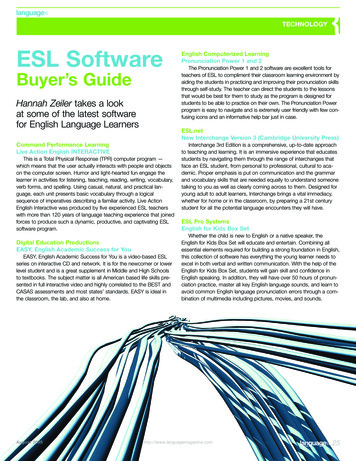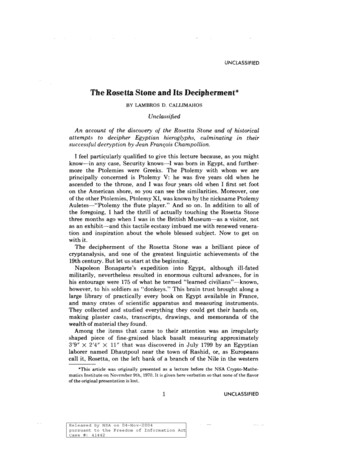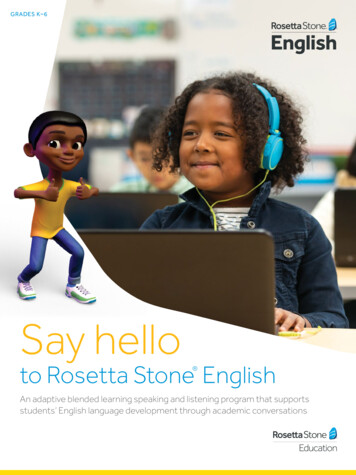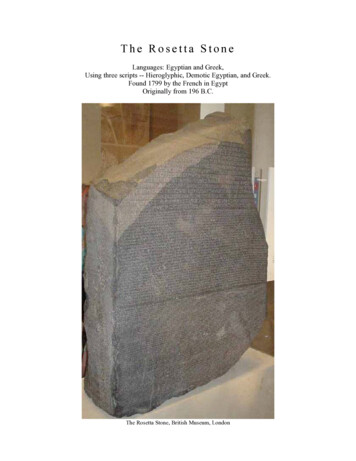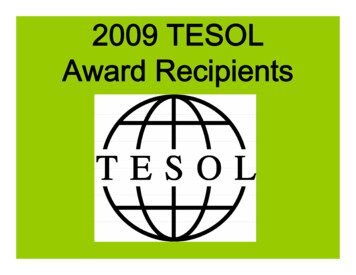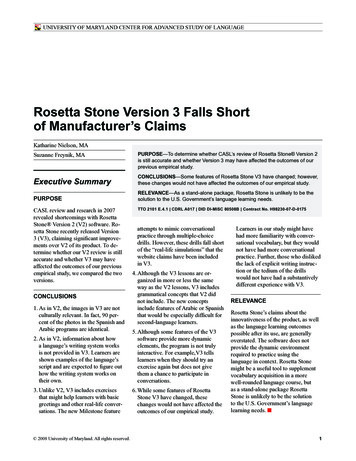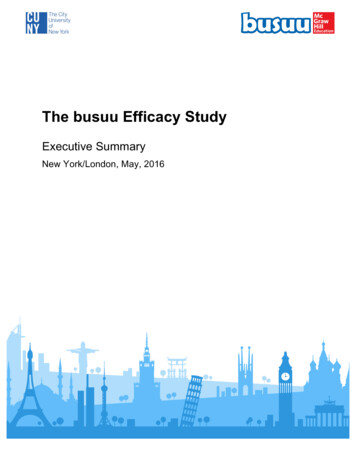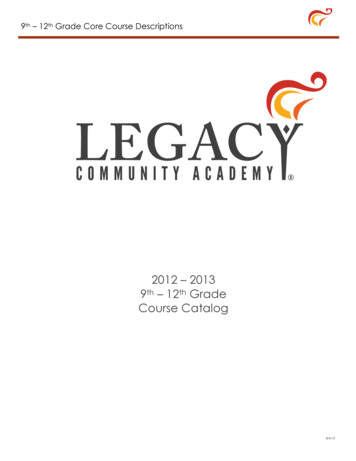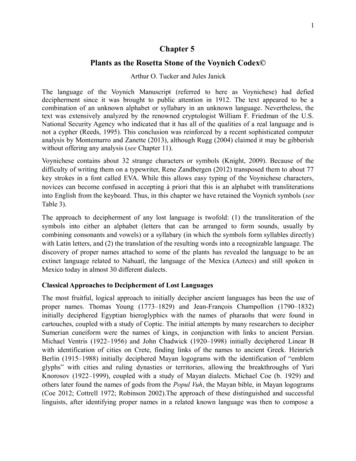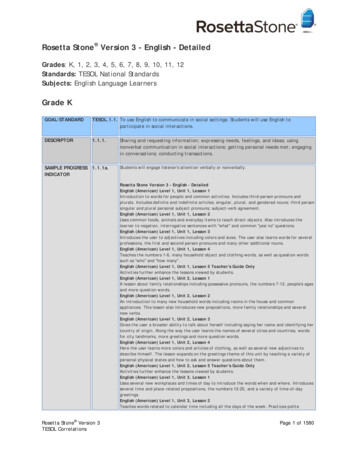
Transcription
Rosetta Stone Version 3 - English - DetailedGrades: K, 1, 2, 3, 4, 5, 6, 7, 8, 9, 10, 11, 12Standards: TESOL National StandardsSubjects: English Language LearnersGrade KGOAL/STANDARDTESOL.1.1. To use English to communicate in social settings: Students will use English toparticipate in social interactions.DESCRIPTOR1.1.1.SAMPLE PROGRESS 1.1.1a.INDICATORSharing and requesting information; expressing needs, feelings, and ideas; usingnonverbal communication in social interactions; getting personal needs met; engagingin conversations; conducting transactions.Students will engage listener's attention verbally or nonverbally.Rosetta Stone Version 3 - English - DetailedEnglish (American) Level 1, Unit 1, Lesson 1Introduction to words for people and common activities. Includes third-person pronouns andplurals. Includes definite and indefinite articles; singular, plural, and gendered nouns; third personsingular and plural personal subject pronouns; subject-verb agreement.English (American) Level 1, Unit 1, Lesson 2Uses common foods, animals and everyday items to teach direct objects. Also introduces thelearner to negation, interrogative sentences with "what" and common "yes/no" questions.English (American) Level 1, Unit 1, Lesson 3Introduces the user to adjectives including colors and sizes. The user also learns words for severalprofessions, the first and second person pronouns and many other additional nouns.English (American) Level 1, Unit 1, Lesson 4Teaches the numbers 1-6, many household object and clothing words, as well as question wordssuch as "who" and "how many".English (American) Level 1, Unit 1, Lesson 5 Teacher's Guide OnlyActivities further enhance the lessons viewed by students.English (American) Level 1, Unit 2, Lesson 1A lesson about family relationships including possessive pronouns, the numbers 7-12, people's agesand more question words.English (American) Level 1, Unit 2, Lesson 2An introduction to many new household words including rooms in the house and commonappliances. This lesson also introduces new prepositions, more family relationships and severalnew verbs.English (American) Level 1, Unit 2, Lesson 3Gives the user a broader ability to talk about herself including saying her name and identifying hercountry of origin. Along the way the user learns the names of several cities and countries, wordsfor city landmarks, more greetings and more question words.English (American) Level 1, Unit 2, Lesson 4Here the user learns more colors and articles of clothing, as well as several new adjectives todescribe himself. The lesson expands on the greetings theme of this unit by teaching a variety ofpersonal physical states and how to ask and answer questions about them.English (American) Level 1, Unit 2, Lesson 5 Teacher's Guide OnlyActivities further enhance the lessons viewed by students.English (American) Level 1, Unit 3, Lesson 1Uses several new workplaces and times of day to introduce the words when and where. Introducesseveral time and place related prepositions, the numbers 13-20, and a variety of time-of-daygreetings.English (American) Level 1, Unit 3, Lesson 2Teaches words related to calendar time including all the days of the week. Practices politeRosetta Stone Version 3TESOL CorrelationsPage 1 of 1580
language, the preposition with, new nouns and verbs related to visiting a friend, more body partsand some sensory words.English (American) Level 1, Unit 3, Lesson 3Shows the user how to communicate about the languages that they do (and do not) speak andwrite. Users learn names of several languages and the numbers from 30 to 60.English (American) Level 1, Unit 3, Lesson 4Introduces reflexive verbs as they are used with a person's morning washing routine. Along the waythe user learns words for common bedroom and bathroom objects, and several new adjectives withthe same theme.English (American) Level 1, Unit 3, Lesson 5 Teacher's GuideActivities further enhance the lessons viewed by students.English (American) Level 1, Unit 4, Lesson 1Opens the shopping unit by teaching the names of several stores and plenty of things to buy inthem. Also uses a number of new verbs to talk about the places and the objects.English (American) Level 1, Unit 4, Lesson 2Teaches the user to express their likes and dislikes and to compare things while teaching severalnew fun things to do around town, several sports and new foods. The lesson continues the shoppingtheme by introducing words related to the cost of items, including common currencies and anumber of related question words.English (American) Level 1, Unit 4, Lesson 3Expands the users ability to shop in their new language by teaching common shopping phrases,different forms of payment, new adjectives that describe objects one shops for, morecomparatives and a variety of words that help us express quantity.English (American) Level 1, Unit 4, Lesson 4Delves more deeply into some of the themes of the previous lesson, especially the quantity andcomparison words. It ends with a prolonged shopping sequence that puts much of what the userhas learned in this unit into a realistic context.English (American) Level 1, Unit 4, Lesson 5Activities further enhance the lessons viewed by students.English (American) Level 2, Unit 1, Lesson 1Follows the theme of getting around town by introducing several types of buildings and stores, andthen teaches the user how to ask for directions and understand how to follow them in their newlanguage.English (American) Level 2, Unit 1, Lesson 2Here the learner discovers words and phrases helpful for using public transportation includingdirectional language, the words for vehicles, the verbs used with the modes of transportation andthe various kinds of transportation stations.English (American) Level 2, Unit 1, Lesson 3Helps the user understand and talk about travel itineraries by teaching more specific time words,more modes of transportation, numbers from 70 to 99 and much more language that us useful inthe airport or train station.English (American) Level 2, Unit 1, Lesson 4Introduces travel destinations and weather language including discussing the temperature andkinds of precipitation and showing the user how to talk about the weather in the future.English (American) Level 2, Unit 1, Lesson 5Activities further enhance the lessons viewed by students.English (American) Level 2, Unit 2, Lesson 1Introduces the past tense, indirect objects and vocabulary about correspondence. Practices thefuture tense.English (American) Level 2, Unit 2, Lesson 2Continues to teach the past and the use of indirect objects while showing the user how to ask forclarification when they don't understand something. Also teaches some school subjects.English (American) Level 2, Unit 2, Lesson 3Introduces and practices the imperfect tense with a variety of verbs. Expands the school theme byteaching different levels of school and students along with some new jobs and workplaces.English (American) Level 2, Unit 2, Lesson 4Continues to teach the past tense and the imperfect by contrasting them. Teaches polite ways tomake requests.English (American) Level 2, Unit 2, Lesson 5Activities further enhance the lessons viewed by students.English (American) Level 2, Unit 3, Lesson 1Builds a base for the social life theme by teaching leisure-time activities and party planninglanguage. Includes many new verbs, the formal imperative and all of the months of the year.Rosetta Stone Version 3TESOL CorrelationsPage 2 of 1580
English (American) Level 2, Unit 3, Lesson 2Continues the planning theme with more language about planning an event, methods ofcommunicating and how to write and say dates. Also practices the formal imperative, introducesthe informal imperative and teaches 100 and 1,000.English (American) Level 2, Unit 3, Lesson 3Here the user learns words for different types of parties, more words for food, more forms ofpossession and phone etiquette. Also introduces the words here, there, this, that, these and those.English (American) Level 2, Unit 3, Lesson 4Concludes the theme of the unit with more party language, more words to make comparisons andhow to accept and decline an invitation.English (American) Level 2, Unit 3, Lesson 5 Teacher's Guide OnlyActivities further enhance the lessons viewed by students.English (American) Level 2, Unit 4, Lesson 1Introduces a new form of the future and a large number and variety of food and restaurantlanguage.English (American) Level 2, Unit 4, Lesson 2Expands the vacation theme by teaching the words for a variety of landmarks, architecturalfeatures, musical instruments and art media.English (American) Level 2, Unit 4, Lesson 3Follows the landmark theme by teaching the words for religious buildings. Adds emotions, sightseeing verbs and sequencing words.English (American) Level 2, Unit 4, Lesson 4Teaches common activities to do while on vacation and adds more places to go, things to see onvacation, vacation-themed clothing and weather words as well.English (American) Level 2, Unit 4, Lesson 5 Teacher's Guide OnlyActivities further enhance the lessons viewed by students.SAMPLE PROGRESS 1.1.1b.INDICATORStudents will volunteer information and respond to questions about self and family.Rosetta Stone Version 3 - English - DetailedEnglish (American) Level 1, Unit 1, Lesson 1Introduction to words for people and common activities. Includes third-person pronouns andplurals. Includes definite and indefinite articles; singular, plural, and gendered nouns; third personsingular and plural personal subject pronouns; subject-verb agreement.English (American) Level 1, Unit 1, Lesson 2Uses common foods, animals and everyday items to teach direct objects. Also introduces thelearner to negation, interrogative sentences with "what" and common "yes/no" questions.English (American) Level 1, Unit 1, Lesson 3Introduces the user to adjectives including colors and sizes. The user also learns words for severalprofessions, the first and second person pronouns and many other additional nouns.English (American) Level 1, Unit 1, Lesson 4Teaches the numbers 1-6, many household object and clothing words, as well as question wordssuch as "who" and "how many".English (American) Level 1, Unit 1, Lesson 5 Teacher's Guide OnlyActivities further enhance the lessons viewed by students.English (American) Level 1, Unit 2, Lesson 1A lesson about family relationships including possessive pronouns, the numbers 7-12, people's agesand more question words.English (American) Level 1, Unit 2, Lesson 2An introduction to many new household words including rooms in the house and commonappliances. This lesson also introduces new prepositions, more family relationships and severalnew verbs.English (American) Level 1, Unit 2, Lesson 3Gives the user a broader ability to talk about herself including saying her name and identifying hercountry of origin. Along the way the user learns the names of several cities and countries, wordsfor city landmarks, more greetings and more question words.English (American) Level 1, Unit 2, Lesson 4Here the user learns more colors and articles of clothing, as well as several new adjectives todescribe himself. The lesson expands on the greetings theme of this unit by teaching a variety ofpersonal physical states and how to ask and answer questions about them.English (American) Level 1, Unit 2, Lesson 5 Teacher's Guide OnlyActivities further enhance the lessons viewed by students.Rosetta Stone Version 3TESOL CorrelationsPage 3 of 1580
English (American) Level 1, Unit 3, Lesson 1Uses several new workplaces and times of day to introduce the words when and where. Introducesseveral time and place related prepositions, the numbers 13-20, and a variety of time-of-daygreetings.English (American) Level 1, Unit 3, Lesson 2Teaches words related to calendar time including all the days of the week. Practices politelanguage, the preposition with, new nouns and verbs related to visiting a friend, more body partsand some sensory words.English (American) Level 1, Unit 3, Lesson 3Shows the user how to communicate about the languages that they do (and do not) speak andwrite. Users learn names of several languages and the numbers from 30 to 60.English (American) Level 1, Unit 3, Lesson 4Introduces reflexive verbs as they are used with a person's morning washing routine. Along the waythe user learns words for common bedroom and bathroom objects, and several new adjectives withthe same theme.English (American) Level 1, Unit 3, Lesson 5 Teacher's GuideActivities further enhance the lessons viewed by students.English (American) Level 1, Unit 4, Lesson 1Opens the shopping unit by teaching the names of several stores and plenty of things to buy inthem. Also uses a number of new verbs to talk about the places and the objects.English (American) Level 1, Unit 4, Lesson 2Teaches the user to express their likes and dislikes and to compare things while teaching severalnew fun things to do around town, several sports and new foods. The lesson continues the shoppingtheme by introducing words related to the cost of items, including common currencies and anumber of related question words.English (American) Level 1, Unit 4, Lesson 3Expands the users ability to shop in their new language by teaching common shopping phrases,different forms of payment, new adjectives that describe objects one shops for, morecomparatives and a variety of words that help us express quantity.English (American) Level 1, Unit 4, Lesson 4Delves more deeply into some of the themes of the previous lesson, especially the quantity andcomparison words. It ends with a prolonged shopping sequence that puts much of what the userhas learned in this unit into a realistic context.English (American) Level 1, Unit 4, Lesson 5Activities further enhance the lessons viewed by students.English (American) Level 2, Unit 1, Lesson 1Follows the theme of getting around town by introducing several types of buildings and stores, andthen teaches the user how to ask for directions and understand how to follow them in their newlanguage.English (American) Level 2, Unit 1, Lesson 2Here the learner discovers words and phrases helpful for using public transportation includingdirectional language, the words for vehicles, the verbs used with the modes of transportation andthe various kinds of transportation stations.English (American) Level 2, Unit 1, Lesson 3Helps the user understand and talk about travel itineraries by teaching more specific time words,more modes of transportation, numbers from 70 to 99 and much more language that us useful inthe airport or train station.English (American) Level 2, Unit 1, Lesson 4Introduces travel destinations and weather language including discussing the temperature andkinds of precipitation and showing the user how to talk about the weather in the future.English (American) Level 2, Unit 1, Lesson 5Activities further enhance the lessons viewed by students.English (American) Level 2, Unit 2, Lesson 1Introduces the past tense, indirect objects and vocabulary about correspondence. Practices thefuture tense.English (American) Level 2, Unit 2, Lesson 2Continues to teach the past and the use of indirect objects while showing the user how to ask forclarification when they don't understand something. Also teaches some school subjects.English (American) Level 2, Unit 2, Lesson 3Introduces and practices the imperfect tense with a variety of verbs. Expands the school theme byteaching different levels of school and students along with some new jobs and workplaces.English (American) Level 2, Unit 2, Lesson 4Continues to teach the past tense and the imperfect by contrasting them. Teaches polite ways toRosetta Stone Version 3TESOL CorrelationsPage 4 of 1580
make requests.English (American) Level 2, Unit 2, Lesson 5Activities further enhance the lessons viewed by students.English (American) Level 2, Unit 3, Lesson 1Builds a base for the social life theme by teaching leisure-time activities and party planninglanguage. Includes many new verbs, the formal imperative and all of the months of the year.English (American) Level 2, Unit 3, Lesson 2Continues the planning theme with more language about planning an event, methods ofcommunicating and how to write and say dates. Also practices the formal imperative, introducesthe informal imperative and teaches 100 and 1,000.English (American) Level 2, Unit 3, Lesson 3Here the user learns words for different types of parties, more words for food, more forms ofpossession and phone etiquette. Also introduces the words here, there, this, that, these and those.English (American) Level 2, Unit 3, Lesson 4Concludes the theme of the unit with more party language, more words to make comparisons andhow to accept and decline an invitation.English (American) Level 2, Unit 3, Lesson 5 Teacher's Guide OnlyActivities further enhance the lessons viewed by students.English (American) Level 2, Unit 4, Lesson 1Introduces a new form of the future and a large number and variety of food and restaurantlanguage.English (American) Level 2, Unit 4, Lesson 2Expands the vacation theme by teaching the words for a variety of landmarks, architecturalfeatures, musical instruments and art media.English (American) Level 2, Unit 4, Lesson 3Follows the landmark theme by teaching the words for religious buildings. Adds emotions, sightseeing verbs and sequencing words.English (American) Level 2, Unit 4, Lesson 4Teaches common activities to do while on vacation and adds more places to go, things to see onvacation, vacation-themed clothing and weather words as well.English (American) Level 2, Unit 4, Lesson 5 Teacher's Guide OnlyActivities further enhance the lessons viewed by students.SAMPLE PROGRESS 1.1.1c.INDICATORStudents will elicit information and ask clarification questions.Rosetta Stone Version 3 - English - DetailedEnglish (American) Level 1, Unit 1, Lesson 3Introduces the user to adjectives including colors and sizes. The user also learns words for severalprofessions, the first and second person pronouns and many other additional nouns.English (American) Level 1, Unit 1, Lesson 4Teaches the numbers 1-6, many household object and clothing words, as well as question wordssuch as "who" and "how many".English (American) Level 1, Unit 2, Lesson 2An introduction to many new household words including rooms in the house and commonappliances. This lesson also introduces new prepositions, more family relationships and severalnew verbs.English (American) Level 1, Unit 2, Lesson 3Gives the user a broader ability to talk about herself including saying her name and identifying hercountry of origin. Along the way the user learns the names of several cities and countries, wordsfor city landmarks, more greetings and more question words.English (American) Level 1, Unit 3, Lesson 1Uses several new workplaces and times of day to introduce the words when and where. Introducesseveral time and place related prepositions, the numbers 13-20, and a variety of time-of-daygreetings.English (American) Level 1, Unit 3, Lesson 2Teaches words related to calendar time including all the days of the week. Practices politelanguage, the preposition with, new nouns and verbs related to visiting a friend, more body partsand some sensory words.English (American) Level 1, Unit 4, Lesson 2Teaches the user to express their likes and dislikes and to compare things while teaching severalnew fun things to do around town, several sports and new foods. The lesson continues the shoppingtheme by introducing words related to the cost of items, including common currencies and aRosetta Stone Version 3TESOL CorrelationsPage 5 of 1580
number of related question words.English (American) Level 2, Unit 1, Lesson 2Here the learner discovers words and phrases helpful for using public transportation includingdirectional language, the words for vehicles, the verbs used with the modes of transportation andthe various kinds of transportation stations.English (American) Level 2, Unit 2, Lesson 5Activities further enhance the lessons viewed by students.English (American) Level 2, Unit 4, Lesson 1Introduces a new form of the future and a large number and variety of food and restaurantlanguage.SAMPLE PROGRESS 1.1.1d.INDICATORStudents will clarify and restate information as needed.Rosetta Stone Version 3 - English - DetailedEnglish (American) Level 1, Unit 1, Lesson 1Introduction to words for people and common activities. Includes third-person pronouns andplurals. Includes definite and indefinite articles; singular, plural, and gendered nouns; third personsingular and plural personal subject pronouns; subject-verb agreement.English (American) Level 1, Unit 1, Lesson 2Uses common foods, animals and everyday items to teach direct objects. Also introduces thelearner to negation, interrogative sentences with "what" and common "yes/no" questions.English (American) Level 1, Unit 1, Lesson 3Introduces the user to adjectives including colors and sizes. The user also learns words for severalprofessions, the first and second person pronouns and many other additional nouns.English (American) Level 1, Unit 1, Lesson 4Teaches the numbers 1-6, many household object and clothing words, as well as question wordssuch as "who" and "how many".English (American) Level 1, Unit 1, Lesson 5 Teacher's Guide OnlyActivities further enhance the lessons viewed by students.English (American) Level 1, Unit 2, Lesson 1A lesson about family relationships including possessive pronouns, the numbers 7-12, people's agesand more question words.English (American) Level 1, Unit 2, Lesson 2An introduction to many new household words including rooms in the house and commonappliances. This lesson also introduces new prepositions, more family relationships and severalnew verbs.English (American) Level 1, Unit 2, Lesson 3Gives the user a broader ability to talk about herself including saying her name and identifying hercountry of origin. Along the way the user learns the names of several cities and countries, wordsfor city landmarks, more greetings and more question words.English (American) Level 1, Unit 2, Lesson 4Here the user learns more colors and articles of clothing, as well as several new adjectives todescribe himself. The lesson expands on the greetings theme of this unit by teaching a variety ofpersonal physical states and how to ask and answer questions about them.English (American) Level 1, Unit 2, Lesson 5 Teacher's Guide OnlyActivities further enhance the lessons viewed by students.English (American) Level 1, Unit 3, Lesson 1Uses several new workplaces and times of day to introduce the words when and where. Introducesseveral time and place related prepositions, the numbers 13-20, and a variety of time-of-daygreetings.English (American) Level 1, Unit 3, Lesson 2Teaches words related to calendar time including all the days of the week. Practices politelanguage, the preposition with, new nouns and verbs related to visiting a friend, more body partsand some sensory words.English (American) Level 1, Unit 3, Lesson 3Shows the user how to communicate about the languages that they do (and do not) speak andwrite. Users learn names of several languages and the numbers from 30 to 60.English (American) Level 1, Unit 3, Lesson 4Introduces reflexive verbs as they are used with a person's morning washing routine. Along the waythe user learns words for common bedroom and bathroom objects, and several new adjectives withthe same theme.English (American) Level 1, Unit 3, Lesson 5 Teacher's GuideRosetta Stone Version 3TESOL CorrelationsPage 6 of 1580
Activities further enhance the lessons viewed by students.English (American) Level 1, Unit 4, Lesson 1Opens the shopping unit by teaching the names of several stores and plenty of things to buy inthem. Also uses a number of new verbs to talk about the places and the objects.English (American) Level 1, Unit 4, Lesson 2Teaches the user to express their likes and dislikes and to compare things while teaching severalnew fun things to do around town, several sports and new foods. The lesson continues the shoppingtheme by introducing words related to the cost of items, including common currencies and anumber of related question words.English (American) Level 1, Unit 4, Lesson 3Expands the users ability to shop in their new language by teaching common shopping phrases,different forms of payment, new adjectives that describe objects one shops for, morecomparatives and a variety of words that help us express quantity.English (American) Level 1, Unit 4, Lesson 4Delves more deeply into some of the themes of the previous lesson, especially the quantity andcomparison words. It ends with a prolonged shopping sequence that puts much of what the userhas learned in this unit into a realistic context.English (American) Level 1, Unit 4, Lesson 5Activities further enhance the lessons viewed by students.English (American) Level 2, Unit 1, Lesson 1Follows the theme of getting around town by introducing several types of buildings and stores, andthen teaches the user how to ask for directions and understand how to follow them in their newlanguage.English (American) Level 2, Unit 1, Lesson 2Here the learner discovers words and phrases helpful for using public transportation includingdirectional language, the words for vehicles, the verbs used with the modes of transportation andthe various kinds of transportation stations.English (American) Level 2, Unit 1, Lesson 3Helps the user understand and talk about travel itineraries by teaching more specific time words,more modes of transportation, numbers from 70 to 99 and much more language that us useful inthe airport or train station.English (American) Level 2, Unit 1, Lesson 4Introduces travel destinations and weather language including discussing the temperature andkinds of precipitation and showing the user how to talk about the weather in the future.English (American) Level 2, Unit 1, Lesson 5Activities further enhance the lessons viewed by students.English (American) Level 2, Unit 2, Lesson 1Introduces the past tense, indirect objects and vocabulary about correspondence. Practices thefuture tense.English (American) Level 2, Unit 2, Lesson 2Continues to teach the past and the use of indirect objects while showing the user how to ask forclarification when they don't understand something. Also teaches some school subjects.English (American) Level 2, Unit 2, Lesson 3Introduces and practices the imperfect tense with a variety of verbs. Expands the school theme byteaching different levels of school and students along with some new jobs and workplaces.English (American) Level 2, Unit 2, Lesson 4Continues to teach the past tense and the imperfect by contrasting them. Teaches polite ways tomake requests.English (American) Level 2, Unit 2, Lesson 5Activities further enhance the lessons viewed by students.English (American) Level 2, Unit 3, Lesson 1Builds a base for the social life theme by teaching leisure-time activities and party planninglanguage. Includes many new verbs, the formal imperative and all of the months of the year.English (American) Level 2, Unit 3, Lesson 2Continues the planning theme with more language about planning an event, methods ofcommunicating and how to write and say dates. Also practices the formal imperative, introducesthe informal imperative and teaches 100 and 1,000.English (American) Level 2, Unit 3, Lesson 3Here the user learns words for different types of parties, more words for food, more forms ofpossession and phone etiquette. Also introduces the words here, there, this, that, these and those.English (American) Level 2, Unit 3, Lesson 4Concludes the theme of the unit with more party language, more words to make comparisons andhow to accept and decline an invitation.Rosetta Stone Version 3TESOL CorrelationsPage 7 of 1580
English (American) Level 2, Unit 3, Lesson 5 Teacher's Guide OnlyActivities further enhance the lessons viewed by students.English (American) Level 2, Unit 4, Lesson 1Introduces a new form of the future and a large number and variety of food and restaurantlanguage.English (American) Level 2, Unit 4, Lesson 2Expands the vacation theme by teaching the words for a variety of landmarks, architecturalfeatures, musical instruments and art media.English (American) Level 2, Unit 4, Lesson 3Follows the landmark theme by teaching the words for religious buildings. Adds emotions, sightseeing verbs and sequencing words.English (American) Level 2, Unit 4, Lesson 4Teaches common activities to do while on vacation and adds more places to go, things to see onvacation, vacation-themed clothing and weather words as well.English (American) Level 2, Unit 4, Lesson 5 Teacher's Guide OnlyActivities further enhance the lessons viewed by students.SAMPLE PROGRESS 1.1.1g.INDICATORStudents will give and ask for permission.Rosetta Stone Version 3 - English - DetailedEnglish (American) Level 1, Unit 1, Lesson 3Introduces the user to adjectives including colors and sizes. The user also learns words for severalprofessions, the first and second person pronouns and many other additional nouns.English (American) Level 1, Unit 1, Lesson 4Teaches the numbers 1-6, many household object and clothing words, as well as question wordssuch as "who" and "how many".English (American) Level 1, Unit 2, Lesson 2An introduction to many new household words including rooms in the house and commonappliances. This lesson also introduces new prepositions, more family relationships and severalnew verbs.English (American) Level 1, Unit 2, Lesson 3Gives the user a broader ability to talk about herself including saying her name and identifying hercountry of origin. Along the way the user learns the names of several cities and countries, wordsfor city landmarks, more greetings and more question words.English (American) Level 1, Unit 3, Lesson 1Uses several new workplaces and times of day to introduce the words when and where. Introducesseveral time and place related preposit
Rosetta Stone Version 3 Page 1 of 1580 TESOL Correlations Rosetta Stone Version 3 - English - Detailed Grades: K, 1, 2, 3, 4, 5, 6, 7, 8, 9,
